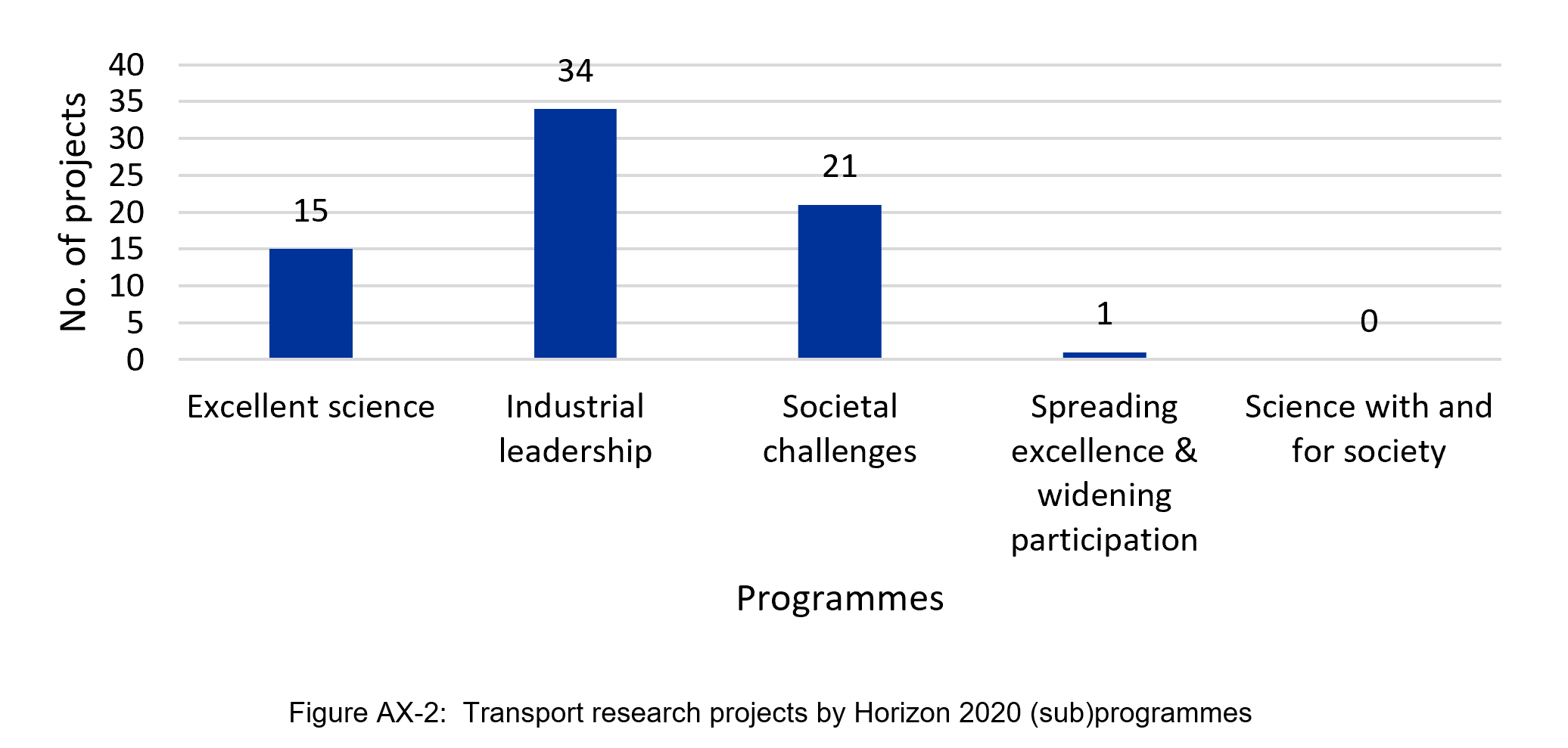R&D - EUON
Transport
This section gives an overview of the Horizon 2020 projects focused on transport. In research classification used by Cordis database, transport issues are analysed under two classifications: social geography/transport and vehicle engineering. The projects that contained the subject classifications “social geography/transport” and “vehicle engineering” were filtered out from the general collection of nanotechnology projects developed for the study.
In the period 2017-2020, Horizon 2020 funded 57 projects in the field of transport. The transport projects comprised 5% of all research projects in nanotechnology funded by the EU in 2017-2020. In general, it shows a relatively low level of interest in transport and nanotechnology.
Analysis of the start date of transport projects shows that most of them received funding and started in 2017 and 2018. H2020 covered the 2014-2020 period, so with 2017 as a mid-term of the programme, it is not surprising that most projects started during this period. The decreasing number of research projects towards the end of the funding period is explained by the fact that most research projects require several years to complete.

H2020 contained several high-level programmes/priorities/specific actions and their sub-programmes. Three thematic and two horizontal high-level programmes funded nanotechnology research and innovation:
- Priority “Excellent science” (1) aimed to improve the excellence of the European research base and consolidate the European Research Area (ERA) to increase the global competitiveness of European research and innovation.
- Priority “Industrial leadership” (2) focused on boosting the development of the technologies and innovations that will underpin future businesses and help innovative European SMEs to grow into world-leading companies. This priority contained a sub-programme targeted at nanotechnologies.
- Priority “Societal challenges” (3) focused on the societal challenges that were identified in the Europe 2020 strategy and aimed to encourage sufficient research and innovation efforts necessary to cope with these challenges and achieve the EU strategic goals.
- Specific objective “Spreading excellence and widening participation” (4) was a horizontal objective of Horizon 2020 aimed at pooling research and innovation talents in Europe, nurturing and connecting pools of excellence to maximise and fully exploit Europe’s research and innovation potential.
- Specific objective “Science with and for society” (5) was a horizontal objective of Horizon 2020 aimed at strengthening the collaboration between science and society by engaging citizens in science and using collective intelligence for solving research problems, promoting scientific careers, etc.
Each of the described high-level programmes contained the whole hierarchy of sub-programmes. Usually, one project received funding through a combination of programmes. Those combinations of (sub)programmes in 2017-2020 were filtered out. Figure 9 11 gives an overview of programmes and subprogrammes that funded transport research under Horizon 2020.

In 2017-2020, Horizon 2020 transport research projects were more focused on industrial innovation than scientific excellence. Most transport projects received funding under the priority “Industrial leadership” and its subprogrammes (34 projects, 60%) that promoted nanotechnology innovation and commercialisation. These subprogrammes are focused on building the capacity of individual researchers and their teams as well as encouraging collaboration between researchers. Substantially less – 21 projects (37%) were funded under the third priority “Social challenges” and the priority “Scientific excellence” (15 projects, 26%).
According to the project classification applied in Cordis, construction projects focused on three topics. One project could combine several topics. In most cases, projects used classes referring to different hierarchical classification levels. For instance, some projects referred to “aerospace engineering” in general, while others specified the focus on aircraft or astronautical engineering, etc.

Most projects focused on aerospace engineering (27 projects, 47%). Other topics – automotive engineering (18 projects, 32%) and electric vehicles (15 projects, 26%) were less visible. Many projects also focus on ICT (see the ICT sector report). An illustrative example of a project focused on the aerospace engineering is provided in the table below.
| Table AII-1: An example of a project focused on water engineering | |||
|---|---|---|---|
| Project title, acronym, (coordinating country) |
Objectives | Start, end dates | Funding (EU contribution) |
| A next generation telecommunication platform based on a nano-satellites constellation, Pearls Constellation (UK) | With a sophisticated and revolutionary telecommunication network infrastructure leveraging nanosatellite technology, the Pearls constellation of 200 nano-satellites will provide affordable and reliable communication services anywhere within the Equatorial band. An advanced space technology, combined with a complex software infrastructure, provides a robust satellite communication platform that can be accessed at a low price and from any commercial cell phone. SAS’s goal is to provide affordable communication services and coverage to billions of people living along the equator who currently have no access to simple communication service. During the feasibility assessment, a detailed scale-up plan to the constellation of 200 nano-satellites will be set up, and a supply chain will be established, as well as plan for the launch of 200 nano-satellites will be drafted. During the second phase of project, SAS will upgrade the software, scale-up the control and management platform, and will launch 5 nano-satellites in Space. |
2019 | € 71 429 |


